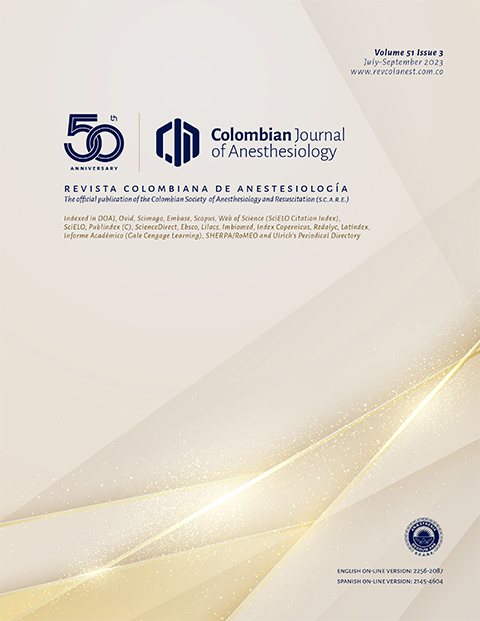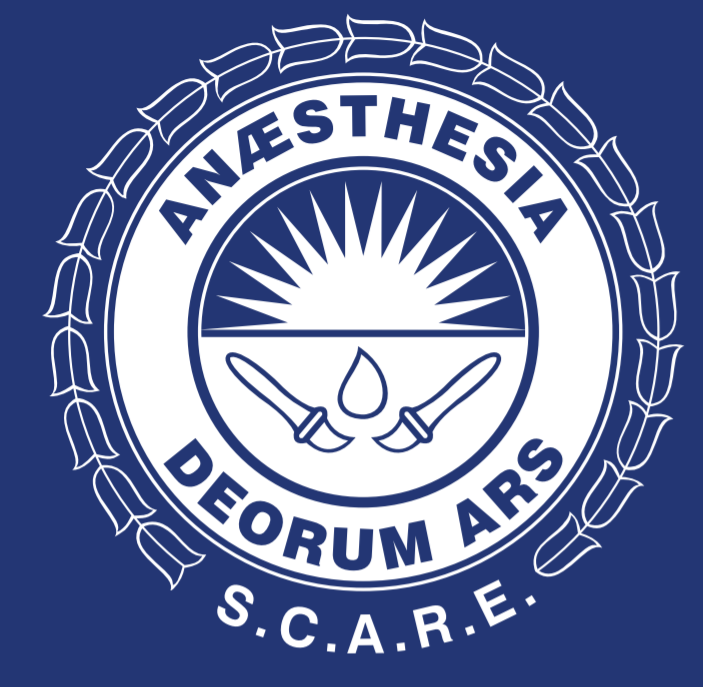Occupational radiation exposure in anesthesia for hepatic chemoembolization: a prospective study
Abstract
Introduction: Anesthetists play an important role during interventional radiology procedures. Like the main operator, anesthetists may also be subject to significant radiation levels in the fluoroscopy suite. Due to its complexity, hepatic chemoembolization procedures demand high fluoroscopic times and digital subtraction angiography images, exposing patients and medical staff to high radiation doses.
Objetive: To assess and quantify the radiation to which one anesthetist was exposed over the course of seven consecutive hepatic chemoembolization procedures, and compare it to the exposure received by the main operator.
Methods: Medical staff dosimetry was evaluated during seven consecutive hepatic chemoembolization procedures conducted in a private hospital in Recife (Brazil), using thermoluminiscent dosimeters placed in regions of the head and torso.
Results: For the seven procedures evaluated in this study, the anesthetist received, on average, absorbed doses to the glabella, left eyebrow, right eyebrow and effective dose of 142.4 ± 72 µSv, 117.3 ± 66 µSv, 137.8 ± 71 µSv and 12.4 ± 8.4 µSv, respectively.
Conclusions: In some cases, ocular dose and effective dose received by the anesthetist may be 4 and 4.7 times greater, respectively, when compared to the main operator. According to the results of this study, the current occupational annual dose limit to the lens of the eye of 20 mSv can be exceeded with only two hepatic chemoembolization procedures per week if adequate radiation protection conditions are not guaranteed.
References
Hidajat N, Wust P, Felix R, Schroder RJ. Radiation exposure to patient and staff in hepatic chemoembolization: risk estimation of cancer and deterministic effects. Cardiovasc Intervent Radiol. 2006;29:791-6. doi: https://doi.org/10.1007/s00270-005-0247-1
Khoury HJ, Garzón WJ, Andrade G, et al. Radiation exposure to patients and medical staff in hepatic chemoembolisation interventional procedures in Recife, Brazil. Radiat Prot Dosimetry. 2015;165:263-7. doi: https://doi.org/10.1093/rpd/ncv075
Kong Y, Gao L, Zhuo W, Qian A. A survey on radiation exposure of primary operators from interventional X-ray procedures. Radiat Meas. 2013;55:43-5. doi: https://doi.org/10.1016/j.radmeas.2013.01.023
International Atomic Energy Agency (IAEA). Occupational radiation protection. International Atomic Energy Agency, IAEA Safety Standards Series No. GSG-7. Vienna; 2018.
Von Boetticher H, Lachmund J, Hoffmann W. An analytic approach to double dosimetry algorithms in occupational dosimetry using energy dependent organ dose conversion coefficients. Health Phys. 2010;99:800-5. doi: https://doi.org/10.1097/HP.0b013e3181e850da
Garzón WJ, Khoury HJ. Radiation doses to anaesthetists during prostatic artery embolization interventional procedures. Radiat Prot Dosimetry. 2019;185:196-200. doi: https://doi.org/10.1093/rpd/ncy295
Kong Y, Struelens L, Vanhavere F, et al. Influence of standing positions and beam projections on effective dose and eye lens dose of anesthetists in interventional procedures. Radiat Prot Dosimetry. 2015;163:181-7. doi: https://doi.org/10.1093/rpd/ncu148
Arii T, Uchino S, Kubo Y, Kiyama S, Uezono S. Radiation exposure to anaesthetists during endovascular procedures. Anaesthesia. 2015;70:47-50. doi: https://doi.org/10.1111/anae.12841
Anastasian ZH, Strozyk D, Meyers PM, Wang S, Berman MF. Radiation exposure of the anesthesiologist in the neurointerventional suite. Anesthesiology. 2011;114:512-20. doi: https://doi.org/10.1097/ALN.0b013e31820c2b81
Choi EJ, Go G, Han WK, Lee P-B. Radiation exposure to the eyes and thyroid during C-arm fluoroscopy-guided cervical epidural injections is far below the safety limit. Korean J Pain. 2020;33(1):73-80. doi: https://doi.org/10.3344/kjp.2020.33.1.73
Ismail S, Khan F, Sultan N, Naqvi M. Radiation exposure to anaesthetists during interventional radiology. Anaesthesia. 2010;65:54-60. doi: https://doi.org/10.1111/j.1365-2044.2009.06166.x
WHITBY M and MARTIN C J. A study of the distribution of dose across the hands of interventional radiologists and cardiologists. Br J Radiol. 2005;78: 219-29. doi: https://doi.org/10.1259/bjr/12209589
Samara ET, Gester D, Furlan M, Pfammatter T, Frauenfelder T, Stussi A. Efficiency evaluation of leaded glasses and visors for eye lens dose reduction during fluoroscopy guided interventional procedures. Physica Medica. 2022;100:129-34. doi: https://doi.org/10.1016/j.ejmp.2022.06.021
Downloads
Copyright (c) 2020 Sociedad Colombiana de Anestesiología y Reanimación (S.C.A.R.E.)

This work is licensed under a Creative Commons Attribution-NonCommercial-NoDerivatives 4.0 International License.
| Article metrics | |
|---|---|
| Abstract views | |
| Galley vies | |
| PDF Views | |
| HTML views | |
| Other views | |














